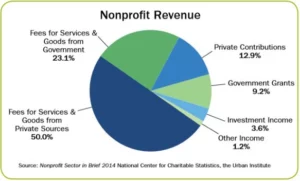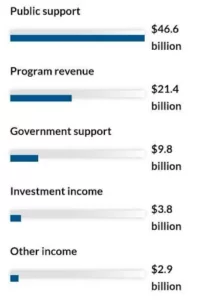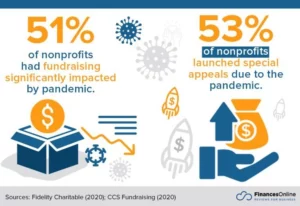A functional organization needs to make money for it to stay afloat. So, the term non-profit does not mean they don’t make money. Ultimately, there would be no need for an organization in the first place.
The definition of non-profit does not lie in the ‘what’ but in the ‘why.’ Why the organization exists. On-profits exist to provide for the needs of society.
That is their primary objective, unlike for-profit institutions whose fundamental goal is to make a profit.
Profits produced by a non-profit organization should be put back into the market in the day-to-day operations. Non-profits include religious groups, charities, educational programs, etc.
How Do Non-profits Make Money?
Although non-profits require money for their daily expenses, such as paying office bills and buying equipment, they are limited in raising these funds. There are four main ways non-profits make money; Selling products and services, donations, grants, and membership fees.
The way revenue is in supply has a significant impact on whether the organization should be taxed. The cost of membership is solely determined by the nation’s tax laws on which the organization is situated.
How Non-Profits Make Money
1. Through Selling Products And Services

A non-profit can raise money by selling goods and providing services. According to the learning candid, the National Center for Charity Statistics puts over 70% of the revenue generated by such institutions on selling goods and services.
However, the goods and services sold must be related to the agenda of the non-profit group. For example, if a charity’s main objective is to save mistreated animals, they can host and sell tickets for an animal fair.
Anything outside of this may attract penalties or even tax exemption revocation. Before any non-profit is firmly established, the founder(s) will have to evaluate the tax policies regarding non-profit organizations thoroughly.
2. Donations
Donations can be monetary or in kind. They can also come from individuals or corporate groups. Still, a bulk of donations come from individuals rather than groups.
According to the balances, 71% of donations are attributed to individuals instead of groups or corporations.
They can contribute once or make it a monthly, weekly, or annual practice. The goal is to make sure there is a reason to keep contributing or donating to the charity.
They can turn no donation away since every penny counts. However, some are known to be key contributors.
These are contributors who donate infrequently but offer significant tributes. An organization should have mechanisms in play to ensure this donor continues to contribute.
3. Grants
Grants can be from the private sector or the government. A majority of government grants go to charities that support health care, education and such limits the number of charities that can apply from the government.
However, they have the option of seeking grants from corporations and the private sector. Usually, the grant given to charities with specific proposals in mind means they are temporary and not continuous grants.
Grants are beneficial, but they are not the most dependable source of a non-profit. They cannot continuously support a running organization.
4. Membership Fees
Members who join charity organizations are required to pay membership fees. Membership fees are an annual fee paid to the institution, and it supports the works that need to be accomplished by the charity.
Continuous members of such organizations are invaluable as they spend their money and invest their time to bring more members to invest.
Members are also considered passionate about the cause of the charity. And means they will go above and beyond to ensure the organization reaches its goals. Which means volunteering to work and expend energy in the organization itself.
Facts On A Nonprofit Organization
The growth of the non-profit sector is being propelled by societal needs and an economic system that promotes its presence.
Here are some statistical facts about non-profits:
- A non-profit organization does not offer its money or assets to its owners or shareholders; instead, it uses it to aid people in need.
- The non-profit sector has shown tremendous growth every year. A good example is the United States which showed a growth of 5% between 2018 and 2019. According to Finance Online, Nonprofit Times quotes the revenue of 2019 being over $84 billion compared to $80billion the previous year.
- Donations by individuals, the private sector, and corporations continued by almost $450billion in 2019. According to Giving USA, this suggests that 2019 saw the highest number in donations at the time.

- The US has 1.8 million non-profits that the government has officially registered. According to Cause IQ, this statistic was calculated in 2020. There still are 1.7 active charities in the 50i(c)(3) category.
- Religious organizations make up a considerable chunk of the total charities and non-profits in the US. They comprise about 17%, followed closely by research and educational institutions at 14%, while grants and foundations take third place with 9%, according to Cause IQ.
- The US charities and non-profits are more likely to receive goods subsidies than monetary donations. It is also evident that the average contributor is over 60 years. The younger generation is yet to embrace the culture of committing to a charity.
However, due to the Coronavirus, there has been an increase in online donations. As an outcome, there has been a considerable growth in donations by 2%. Blackbaud has estimated an increase in online benefactor activity by 21%.
- Most donors are not likely to give more or less because of the Corona pandemic. More than 50% have maintained that they will continue giving as they have been. Another 25% pleaded to give more given the opportunity.
- More of the elderly are charitable than the younger generation in the UK. The UK government has estimated that 85% of those older than 75 contributed to non-profits in 2020. Compared to 55% of people aged 16 to 25.
This means the younger generation has no idea of the importance of giving.
- A majority of non-profits based in the US were severely affected by the corona pandemic. Some had to spend more time fundraising, while others depended on grants and downsizing.

Differences Between Nonprofit And For Profit
There are basic facts that differentiate non-profits from for-profit organizations. Here is a list of differences:
- For-profit organization bottom line is profit. The main goal is to make more money so that the shareholder can profit in the end. On the other hand, non-profits’ primary objective is to improve society by meeting needs.
The profit made goes back to the organization’s operations.
- For-profit organizations get their money solely from selling goods and services. This way, they can get as much profit as they can. While non-profit organizations can use services and products to generate funds, it is restricted.
However, they can raise revenue by applying for government grants, donations from members of society and individuals.
- Non-profit organizations are exempted from paying taxes. The majority of non-profit organizations do not pay taxes unless they break the restrictions of their tax-exempt status.
For-profit organizations have to pay taxes on the revenue they generate. The taxes vary depending on what business they are running.
- For-profit businesses are concerned with the bottom line, profit, which involves fulfilling deadlines, completing projects, and participating in meetings after meetings. The workforce is under pressure to meet certain thresholds.
As a result, the work atmosphere is significantly more stressful than otherwise. Non-profits, on the other hand, are all about society. This suggests that the bottom line is about filling a need, and there is no time limit for doing so. Yes, money is needed, but not how that drives the for-profit sector.
- In the case of for-profit, the organization has to identify a specific section of the population to target.
The products and services are then streamlined to suit that specific demographic, which leaves a high section of the society that the organization does not particularly target. Non-profit institutions mainly focus on society as a whole.
The main objective is to look for a need that the organization can meet, which is the organization’s focus.
- Specific documentation is needed for for-profit organizations. Financial statements such as cash flow sheets, statement income, balance sheets are integral in for-profit institutions.
On the other hand, non-profits do not require some objective cases. The key documents that run charities include balance sheets, incomes and expenditure accounts, etc. Non-profits do not require a lot of documentation because they do not have the same goals.
Conclusion
The world of non-profits is usually easy to navigate. However, the waters can be very murky if one does not have the correct information. It is critical to conduct a comprehensive study and find the correct information from informed people.
If someone wants to establish a non-profit or charity, the prudent thing to do is visit a lawyer. They will then advise on the best cause of action. This article is intended to provide an overview of locating the majority of charities.


